Related Research Articles

Fluorite (also called fluorspar) is the mineral form of calcium fluoride, CaF2. It belongs to the halide minerals. It crystallizes in isometric cubic habit, although octahedral and more complex isometric forms are not uncommon.

Celestine (the IMA-accepted name) or celestite is a mineral consisting of strontium sulfate (SrSO4). The mineral is named for its occasional delicate blue color. Celestine and the carbonate mineral strontianite are the principal sources of the element strontium, commonly used in fireworks and in various metal alloys.

Strontianite (SrCO3) is an important raw material for the extraction of strontium. It is a rare carbonate mineral and one of only a few strontium minerals. It is a member of the aragonite group.

Cassiterite is a tin oxide mineral, SnO2. It is generally opaque, but it is translucent in thin crystals. Its luster and multiple crystal faces produce a desirable gem. Cassiterite was the chief tin ore throughout ancient history and remains the most important source of tin today.
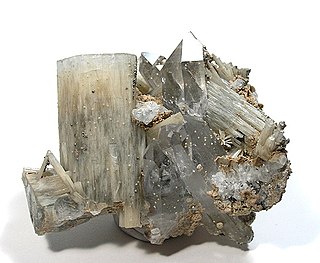
Zinnwaldite, KLiFeAl(AlSi3)O10(OH,F)2, potassium lithium iron aluminium silicate hydroxide fluoride is a silicate mineral in the mica group. The IMA status is as a series between siderophyllite (KFe2Al(Al2Si2)O10(F,OH)2) and polylithionite (KLi2AlSi4O10(F,OH)2) and not considered a valid mineral species.

Strontium fluoride, SrF2, also called strontium difluoride and strontium(II) fluoride, is a fluoride of strontium. It is a brittle white crystalline solid. In nature, it appears as the very rare mineral strontiofluorite.
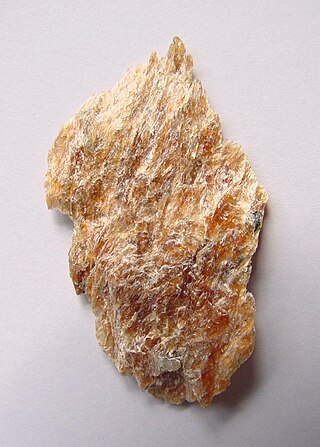
Yuksporite is a rare inosilicate mineral with double width, unbranched chains, and the complicated chemical formula K4(Ca,Na)14Sr2Mn(Ti,Nb)4(O,OH)4(Si6O17)2(Si2O7)3(H2O,OH)3. It contains the relatively rare elements strontium, titanium and niobium, as well as the commoner metallic elements potassium, calcium, sodium and manganese. As with all silicates, it contains groups of linked silicon and oxygen atoms, as well as some associated water molecules.
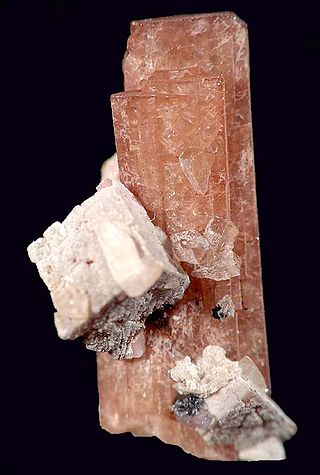
Ancylite is a group of hydrous strontium carbonate minerals containing cerium, lanthanum and minor amounts of other rare-earth elements. The chemical formula is Sr(Ce,La)(CO3)2(OH)·H2O with ancylite-Ce enriched in cerium and ancylite-La in lanthanum.
Frankdicksonite is a halide mineral with the chemical formula BaF2 which corresponds to the chemical compound barium fluoride. It occurs in the Carlin gold deposit of Eureka County, Nevada as cubic crystals sized between 0.1 and 4 mm, and is of hydrothermal origin. Its only associated mineral is quartz and the frankdicksonite crystals are always completely encapsulated in it. Frankdicksonite has fluorite crystal structure with a cubic symmetry and the lattice constant a = 619.64 pm. Its Vickers hardness on the {111} cleavage crystal faces varies between 88 and 94 kg/mm2 and is close to that of the synthetic barium fluoride (95 kg/mm2). Its refractive index (1.475) is almost identical to that of BaF2 (1.474). Under electron irradiation, it emits strong blue cathodoluminescence. The major impurity in frankdicksonite is strontium with concentrations up to 0.5% by weight. Also present are silicon (0.02%) and magnesium (0.0015%); other impurities have concentrations below 0.0015%.

Lulzacite is a strontium-containing phosphate mineral with the chemical formula Sr2Fe2+(Fe2+,Mg)2Al4(PO4)4(OH)10.
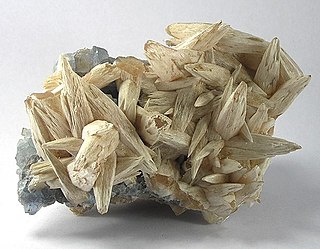
Benstonite is a mineral with formula Ba6Ca6Mg(CO3)13. Discovered in 1954, the mineral was described in 1961 and named after Orlando J. Benston (1901–1966).
Carbokentbrooksite is a very rare mineral of the eudialyte group, with formula (Na,□)12(Na,Ce)3Ca6Mn3Zr3NbSiO(Si9O27)2(Si3O9)2(OH)3(CO3).H2O. The original formula was extended to show the presence of cyclic silicate groups and silicon at the M4 site, according to the nomenclature of eudialyte group. Carbokenbrooksite characterizes in being carbonate-rich (the other eudialyte-group species with essential carbonate are zirsilite-(Ce), golyshevite, and mogovidite). It is also sodium rich, being sodium equivalent of zirsilite-(Ce), with which it is intimately associated.

Zirsilite-(Ce) is a very rare mineral of the eudialyte group, with formula (Na,□)12(Ce,Na)3Ca6Mn3Zr3NbSi(Si9O27)2(Si3O9)2O(OH)3(CO3)·H2O. The original formula was extended to show the presence of cyclic silicate groups and the presence of silicon at the M4 site, according to the nomenclature of the eudialyte group.according to the nomenclature of eudialyte group. Zirsilite-(Ce) differs from carbokentbrooksite in cerium-dominance over sodium only. Both minerals are intimately associated. The only other currently known representative of the eudialyte group having rare earth elements (in particular cerium, as suggested by the "-Ce)" Levinson suffix in the name) in dominance is johnsenite-(Ce).

Ferrokentbrooksite is a moderately rare mineral of the eudialyte group, with formula Na15Ca6(Fe,Mn)3Zr3NbSi25O73(O,OH,H2O)3(Cl,F,OH)2. The original formula was extended form to show the presence of cyclic silicate groups and presence of silicon at the M4 site, according to the nomenclature of eudialyte group. As suggested by its name, it is the (ferrous) iron analogue of kentbrooksite. When compared to the latter, it is also chlorine-dominant instead of being fluorine-dominant. The original (holotype) material is also relatively enriched in rare earth elements, including cerium and yttrium.

Manganoeudialyte is an moderately rare mineral of the eudialyte group, with formula Na14Ca6Mn3Zr3Si2[Si24O72(OH)2]Cl2·4H2O. The formula given is one of the forms that can be given, based on the originally reported one, and shows dominance of silicon at both the M3 and M4 sites. As suggested by its name, it is the manganese-analogue of eudialyte.

Cerianite-(Ce) is a relatively rare oxide mineral, belonging to uraninite group with the formula (Ce,Th)O
2. It is one of a few currently known minerals containing essential tetravalent cerium, the other examples being stetindite and dyrnaesite-(La).
Faizievite is a very rare mineral with the formula K2Na(Ca6Na)Ti4Li6Si24O66F2. This triclinic mineral is chemically related to baratovite and katayamalite. Faizievite is a single-locality mineral, coming from the moraine of the Darai-Pioz glacier, Tien Shan Mountains, Tajikistan. Alkaline rocks of this site are famous for containing numerous rare minerals, often enriched in boron, caesium, lithium, titanium, rare earth elements, barium, and others.
Zhangpeishanite was named for Zhang Peishan mineralogist due to his contributions to Bayan Obo, where the mineral is a type locality. The Bayan Obo deposit is also known for being a world class deposit. The mineral got approved by the IMA in 2006 but was published two years after its approval.
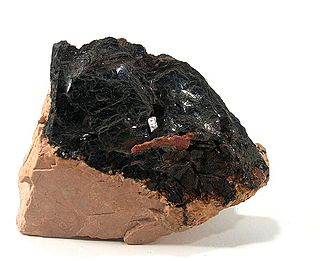
Bannisterite is a mineral named in honor of mineralogist and x-ray crystallographer Dr. Frederick Allen Bannister (1901-1970). It is a calcium-dominant member of the ganophyllite group, and was previously identified as ganophyllite in 1936, but otherwise it is structurally related to the stilpnomelane group. It was approved by the IMA in 1967.

Sarcolite is a mineral named due to its color. Its name originates from the Greek word sárx (σάρξ), meaning flesh and from the Greek word for stone, líthos (λίθος), for being a mineral. It was first described in 1959, but had been a valid species since 1807. It is grandfathered, meaning the name sarcolite still refers to a valid species till this day. Researchers were able to create lab-grown sarcolites with the same crystal structure and formula, although the lab grown ones show different, uniaxial (-) optical properties.
References
- ↑ Warr, L.N. (2021). "IMA–CNMNC approved mineral symbols". Mineralogical Magazine. 85 (3): 291–320. Bibcode:2021MinM...85..291W. doi: 10.1180/mgm.2021.43 . S2CID 235729616.
- ↑ "Strontiofluorite: Strontiofluorite mineral information and data". mindat.org. Retrieved 2017-03-10.